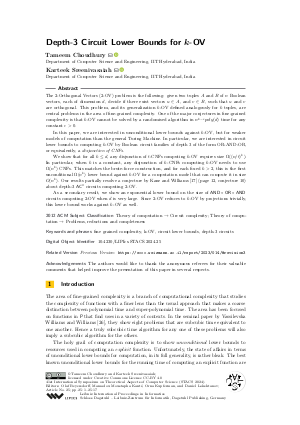@InProceedings{choudhury_et_al:LIPIcs.STACS.2024.25,
author = {Choudhury, Tameem and Sreenivasaiah, Karteek},
title = {{Depth-3 Circuit Lower Bounds for k-OV}},
booktitle = {41st International Symposium on Theoretical Aspects of Computer Science (STACS 2024)},
pages = {25:1--25:17},
series = {Leibniz International Proceedings in Informatics (LIPIcs)},
ISBN = {978-3-95977-311-9},
ISSN = {1868-8969},
year = {2024},
volume = {289},
editor = {Beyersdorff, Olaf and Kant\'{e}, Mamadou Moustapha and Kupferman, Orna and Lokshtanov, Daniel},
publisher = {Schloss Dagstuhl -- Leibniz-Zentrum f{\"u}r Informatik},
address = {Dagstuhl, Germany},
URL = {https://drops.dagstuhl.de/entities/document/10.4230/LIPIcs.STACS.2024.25},
URN = {urn:nbn:de:0030-drops-197359},
doi = {10.4230/LIPIcs.STACS.2024.25},
annote = {Keywords: fine grained complexity, k-OV, circuit lower bounds, depth-3 circuits}
}

 Creative Commons Attribution 4.0 International license
Creative Commons Attribution 4.0 International license




